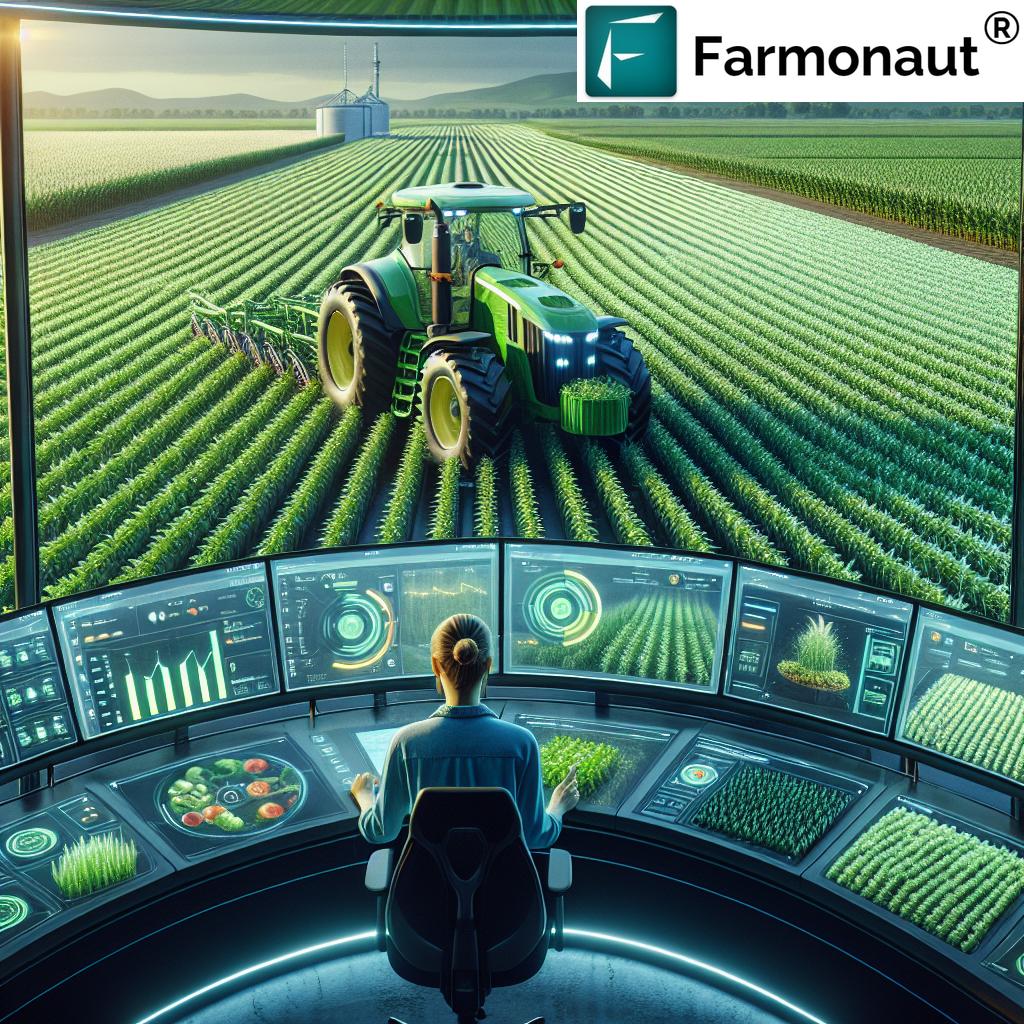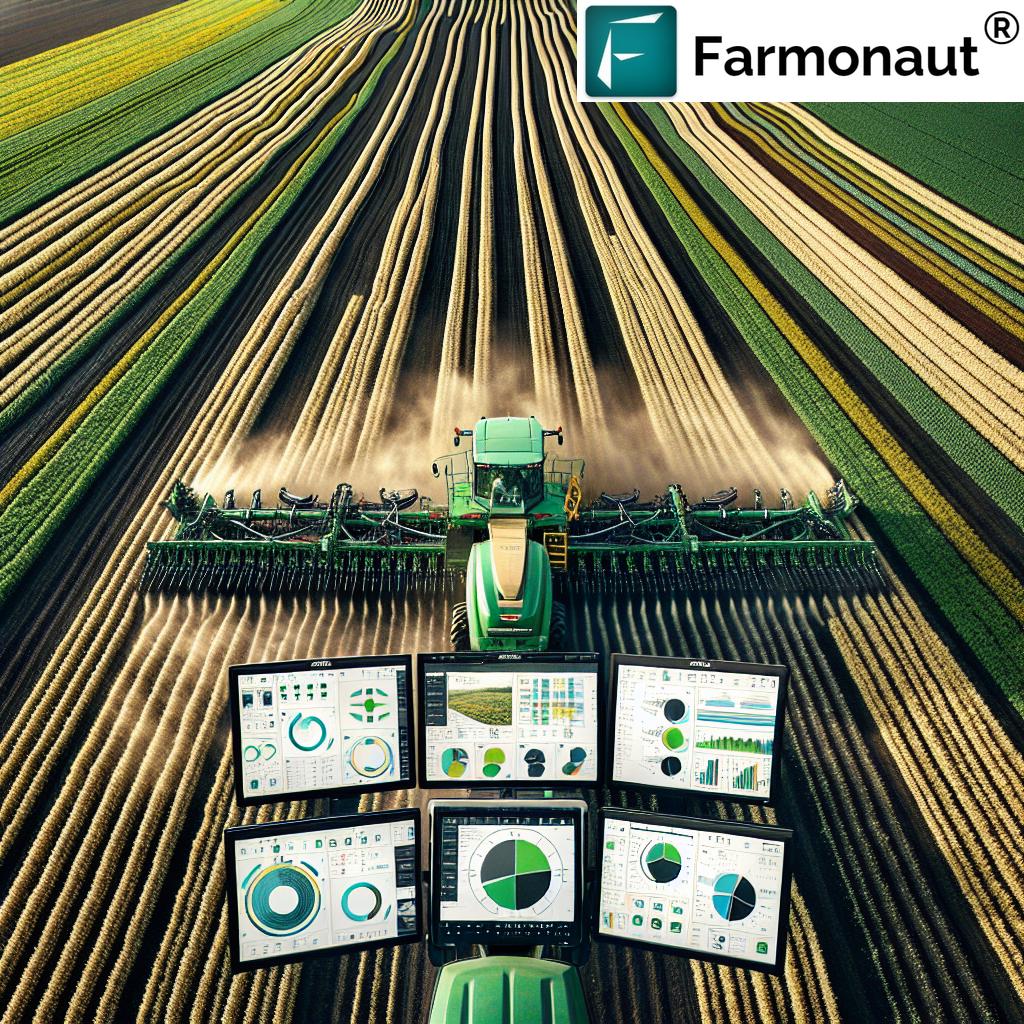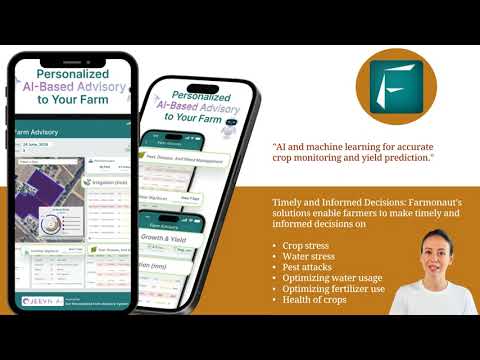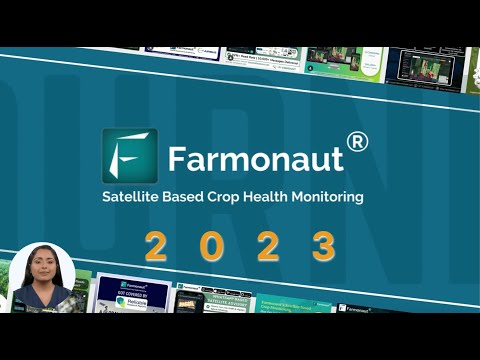Revolutionizing Minnesota Farms: How Precision Agriculture Technology Boosts Efficiency and Profitability
“Precision agriculture technologies can increase crop yields by up to 20% while reducing water usage by 30%.”
Welcome to the future of farming in Minnesota! We’re excited to take you on a journey through the revolutionary world of precision agriculture and how it’s transforming the landscape of our beloved North Star State. As we delve into the cutting-edge technologies reshaping our farmlands, we’ll explore how these innovations are not just changing the way we farm, but are also significantly boosting efficiency and profitability for farmers across the state.
The Dawn of Precision Farming in Minnesota
Minnesota, with its vast acres of fertile land, has long been a cornerstone of American agriculture. However, the challenges faced by our farmers – from unpredictable weather patterns to resource management – have necessitated a shift towards more innovative farming practices. This is where precision agriculture comes into play, revolutionizing our approach to crop cultivation and land management.
Precision farming technologies are at the forefront of this agricultural revolution. These smart farming solutions integrate advanced machinery, sophisticated computer systems, and data-driven decision-making to optimize every aspect of farm operations. From the cab of a modern tractor to the screens of smartphones, precision agriculture is changing the very fabric of farmlife in Minnesota.

The Backbone of Precision Agriculture: Advanced Machinery and Equipment
At the heart of precision agriculture lies a suite of advanced machinery and equipment designed to enhance every facet of farming operations. Let’s explore some of the key technologies that are making waves across Minnesota’s farmsteads:
- Autosteering in Agriculture: Gone are the days of manual steering across vast fields. Autosteering systems, guided by GPS technology, allow tractors and other farm equipment to navigate fields with centimeter-level accuracy. This precision not only reduces operator fatigue but also minimizes overlap in seeding, spraying, and harvesting, leading to significant savings in time, fuel, and resources.
- Variable Rate Technology (VRT): This innovative system allows for the precise application of inputs such as seeds, fertilizers, and pesticides. By adjusting application rates based on soil conditions, crop health, and other factors, VRT ensures that resources are used efficiently, reducing waste and optimizing crop yield.
- Precision Planting Equipment: Modern planters equipped with precision technology can control the depth, spacing, and even the downforce applied to each seed. This level of control ensures optimal seed placement, leading to improved germination rates and ultimately, better yields.
These advancements in farm machinery are not just about having the latest gadgets; they represent a fundamental shift in how we approach farming. By integrating these technologies, Minnesota farmers are seeing remarkable improvements in efficiency, leading to increased profitability and sustainability.
The Power of Data: Agricultural Telemetry Systems
In the era of big data, information is power, and nowhere is this more evident than in modern agriculture. Agricultural telemetry systems are transforming the way we collect, analyze, and utilize farm data. These systems provide real-time information on various aspects of farm operations, enabling farmers to make informed decisions quickly and effectively.
- Remote Monitoring of Farm Equipment: Telemetry systems allow farmers to track the performance and location of their machinery in real-time. This capability is invaluable for managing large operations, optimizing equipment usage, and quickly addressing any issues that may arise.
- Crop Health Monitoring: Advanced sensors and imaging technologies provide detailed information on crop health, soil moisture levels, and nutrient content. This data helps farmers identify potential issues early and take targeted action to protect their crops.
- Weather Stations: On-farm weather stations collect localized data, providing farmers with accurate, field-specific weather information. This precision allows for better planning of planting, spraying, and harvesting activities.
The integration of these telemetry systems with precision agriculture software creates a powerful tool for farm management. Farmers can access this wealth of data through user-friendly interfaces on their computers or mobile devices, making data-driven farming accessible even in the field.
Precision Agriculture Software: The Brain Behind the Operation
The true power of precision agriculture lies in the sophisticated software that interprets and analyzes the vast amounts of data collected from various sources. These precision agriculture software platforms are the command centers of modern farms, providing insights and recommendations that drive decision-making.
Key features of precision agriculture software include:
- Field Mapping and Analysis: Create detailed maps of fields, including information on soil types, elevation, and crop performance. This allows for the identification of management zones within fields for targeted interventions.
- Yield Forecasting: By analyzing historical data and current conditions, these systems can provide accurate yield predictions, helping farmers plan for harvest and marketing.
- Input Management: Track and optimize the use of seeds, fertilizers, and pesticides across different areas of the farm, ensuring efficient resource allocation.
- Integration with Farm Equipment: Many software platforms can directly communicate with farm machinery, allowing for seamless implementation of variable rate applications and other precision farming techniques.
One company at the forefront of providing such innovative solutions is Farmonaut. Their platform offers advanced, satellite-based farm management solutions that integrate seamlessly with existing farm operations. Through their web app, Android app, and iOS app, Farmonaut provides farmers with real-time insights into crop health, weather patterns, and more, empowering them to make data-driven decisions that optimize their operations.


“Farmers using autosteering systems in agriculture can reduce fuel consumption by up to 15% and minimize overlap by 90%.”
Revolutionizing Field Operations: From Tillage to Harvest
Precision agriculture technologies are transforming every stage of crop production in Minnesota, from preparing the soil to bringing in the harvest. Let’s explore how these innovations are impacting key field operations:
Precision Tillage
Modern tillage equipment equipped with GPS guidance and variable-depth control allows farmers to optimize soil preparation based on specific field conditions. This targeted approach helps conserve fuel, reduce soil compaction, and create an ideal seedbed for planting.
Smart Seeding
Precision planters use a combination of GPS guidance, automated seed delivery systems, and real-time soil data to ensure optimal seed placement. These systems can adjust seeding rates on-the-go, accounting for variations in soil type, moisture levels, and other factors across the field.
Intelligent Irrigation
Precision irrigation systems use soil moisture sensors, weather data, and crop-specific algorithms to deliver water exactly where and when it’s needed. This not only conserves water but also promotes optimal crop growth and reduces the risk of disease.
Targeted Fertilizer Application
Variable rate technology allows for the precise application of fertilizers based on soil nutrient maps and crop needs. This ensures that every part of the field receives the right amount of nutrients, maximizing yield potential while minimizing waste and environmental impact.
Precision Harvesting
Modern combine harvesters equipped with yield monitors and GPS tracking provide real-time data on crop yields across the field. This information is invaluable for future planning and helps identify areas of the field that may require special attention.

The Role of Remote Sensing in Precision Agriculture
Remote sensing technologies, particularly satellite imagery and drone-based systems, are playing an increasingly important role in precision agriculture. These tools provide farmers with a bird’s-eye view of their fields, offering insights that would be impossible to gather from ground level.
Key applications of remote sensing in agriculture include:
- Crop Health Monitoring: Multispectral and hyperspectral imaging can detect stress in crops before it’s visible to the naked eye, allowing for early intervention.
- Soil Moisture Mapping: Satellite-based sensors can provide large-scale maps of soil moisture content, helping farmers optimize irrigation strategies.
- Yield Prediction: By analyzing vegetation indices over time, remote sensing can provide accurate yield forecasts well before harvest.
- Pest and Disease Detection: Advanced imaging techniques can identify the early signs of pest infestations or disease outbreaks, enabling targeted treatment.
Companies like Farmonaut are at the forefront of bringing these remote sensing capabilities to farmers. Through their satellite-based crop health monitoring system, farmers can access up-to-date information on their fields’ conditions, enabling them to make timely and informed decisions.
The Economic Impact: Boosting Profitability Through Precision
The adoption of precision agriculture technologies in Minnesota is not just about embracing new gadgets; it’s about significantly improving the bottom line for farmers. Here’s how these technologies are boosting profitability:
- Reduced Input Costs: By applying seeds, fertilizers, and pesticides only where and when they’re needed, farmers can significantly reduce their input costs without sacrificing yield.
- Improved Yield: Precision agriculture techniques can lead to more consistent and higher yields across fields by optimizing growing conditions for each plant.
- Enhanced Efficiency: Automation and precision guidance reduce labor costs and allow for more efficient use of machinery, saving time and fuel.
- Better Risk Management: Real-time data and predictive analytics help farmers make informed decisions, reducing the risks associated with weather, pests, and market fluctuations.
- Access to Premium Markets: The ability to track and document farming practices can help farmers access premium markets that demand sustainably produced crops.
While the initial investment in precision agriculture technologies can be significant, many Minnesota farmers are finding that the return on investment is substantial and often realized within a few growing seasons.
Overcoming Challenges: Adapting to Precision Agriculture
While the benefits of precision agriculture are clear, the transition to these new technologies is not without its challenges. Some of the hurdles Minnesota farmers face include:
- Initial Investment: The cost of upgrading equipment and implementing new systems can be substantial, particularly for smaller farms.
- Learning Curve: Adopting new technologies requires time and effort to learn and integrate them effectively into existing operations.
- Data Management: The sheer volume of data generated by precision agriculture systems can be overwhelming. Effective data management and interpretation are crucial.
- Connectivity Issues: Many precision agriculture technologies rely on robust internet connectivity, which can be a challenge in some rural areas of Minnesota.
To address these challenges, many farmers are turning to agricultural technology providers like Farmonaut, which offer comprehensive solutions that are both powerful and user-friendly. Farmonaut’s platform is designed to be accessible to farmers of all scales, helping to democratize access to precision agriculture technologies.
The Future of Farming in Minnesota: Embracing Innovation
As we look to the future, it’s clear that precision agriculture will play an increasingly important role in shaping Minnesota’s agricultural landscape. Emerging technologies such as artificial intelligence, machine learning, and the Internet of Things (IoT) are set to take precision farming to new heights.
Some exciting developments on the horizon include:
- AI-Powered Decision Support: Advanced algorithms will provide even more accurate and personalized recommendations for farm management.
- Autonomous Farm Equipment: Self-driving tractors and other machinery will further reduce labor requirements and increase efficiency.
- Advanced Sensors and IoT Integration: A network of interconnected sensors will provide real-time data on every aspect of farm operations, from soil conditions to equipment performance.
- Blockchain for Traceability: Blockchain technology will enhance supply chain transparency, allowing consumers to trace their food from farm to table.
Companies like Farmonaut are at the forefront of these innovations, continuously developing new tools and technologies to support farmers in this evolving landscape. Their commitment to making precision agriculture accessible and affordable is helping to ensure that farms of all sizes can benefit from these advancements.
Comparative Analysis: Traditional vs. Precision Agriculture Practices in Minnesota
To fully appreciate the impact of precision agriculture on Minnesota farms, let’s compare traditional farming methods with modern precision techniques across key aspects of farm management:
| Farming Aspect | Traditional Method | Precision Agriculture Method |
|---|---|---|
| Soil Analysis | Periodic soil sampling of entire fields | Continuous, GPS-guided soil sampling with real-time analysis |
| Crop Monitoring | Visual inspection and manual scouting | Satellite imagery, drone surveys, and IoT sensors for real-time crop health data |
| Irrigation | Uniform watering based on general field conditions | Variable rate irrigation based on precise soil moisture data and crop needs |
| Fertilizer Application | Blanket application across entire fields | Variable rate application based on soil nutrient maps and crop requirements |
| Pest Control | Scheduled, uniform pesticide applications | Targeted pest management using predictive models and precision spraying |
| Yield Forecasting | Estimates based on historical data and visual assessment | Data-driven predictions using AI algorithms and multi-year field performance data |
This comparison clearly illustrates the significant advancements that precision agriculture brings to farming operations. By adopting these technologies, Minnesota farmers can achieve substantial improvements in efficiency, sustainability, and profitability.
Embracing the Precision Agriculture Revolution in Minnesota
As we’ve explored throughout this article, precision agriculture is revolutionizing farming practices in Minnesota, offering unprecedented opportunities for efficiency, sustainability, and profitability. From advanced machinery and remote sensing technologies to sophisticated data analytics and AI-driven decision support, these innovations are reshaping every aspect of farm management.
For Minnesota farmers looking to embrace this technological revolution, platforms like Farmonaut offer an accessible entry point into the world of precision agriculture. With their user-friendly apps and comprehensive suite of tools, Farmonaut is helping farmers of all scales leverage the power of satellite technology and data-driven insights to optimize their operations.
As we look to the future, it’s clear that precision agriculture will play an increasingly crucial role in addressing the challenges facing modern farming, from climate change to resource scarcity. By adopting these technologies, Minnesota’s farmers are not just improving their own operations but are also contributing to a more sustainable and productive agricultural sector for generations to come.
Frequently Asked Questions
- What is precision agriculture?
Precision agriculture is a farming management concept that uses technology to observe, measure, and respond to variability in crops, fields, and animals. It aims to optimize returns on inputs while preserving resources. - How does precision agriculture benefit Minnesota farmers?
It helps farmers increase efficiency, reduce costs, improve crop yields, and minimize environmental impact through targeted resource application and data-driven decision-making. - What technologies are commonly used in precision agriculture?
Common technologies include GPS guidance systems, remote sensing, IoT sensors, variable rate technology, and farm management software. - Is precision agriculture only for large farms?
No, while initially adopted by larger operations, precision agriculture tools are becoming increasingly accessible and beneficial for farms of all sizes. - How can I get started with precision agriculture on my farm?
Start by identifying your farm’s specific needs and goals. Consider beginning with basic technologies like GPS guidance or remote sensing, and gradually integrate more advanced solutions as you become comfortable with the technology.
Conclusion: The Future is Precision
As we’ve explored throughout this article, precision agriculture is not just a passing trend; it’s the future of farming in Minnesota and beyond. By embracing these technologies, farmers can optimize their operations, increase yields, reduce costs, and contribute to more sustainable agricultural practices. While the transition may seem daunting, the long-term benefits far outweigh the initial challenges.
Companies like Farmonaut are playing a crucial role in making precision agriculture accessible and effective for farmers of all scales. Their innovative solutions, from satellite-based crop monitoring to AI-driven advisory systems, are empowering farmers to make data-driven decisions and maximize their farm’s potential.
As we look to the future, it’s clear that the farms that thrive will be those that embrace innovation and leverage the power of precision agriculture. For Minnesota’s agricultural community, this technological revolution represents an exciting opportunity to lead the way in efficient, profitable, and sustainable farming practices.
Ready to take your farm into the future? Explore Farmonaut’s precision agriculture solutions and start your journey towards more efficient and profitable farming today.

For developers interested in integrating Farmonaut’s powerful satellite and weather data into their own applications, check out our API and API Developer Docs.
Farmonaut Subscription Plans
By embracing precision agriculture technologies and partnering with innovative companies like Farmonaut, Minnesota’s farmers are well-positioned to lead the way in the next agricultural revolution. The future of farming is here, and it’s precise, data-driven, and more sustainable than ever before.



